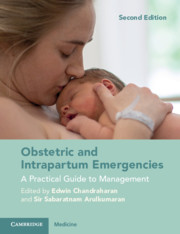Book contents
- Obstetric and Intrapartum Emergencies
- Obstetric and Intrapartum Emergencies
- Copyright page
- Contents
- Contributors
- Preface
- Preface to the First Edition
- Acknowledgements
- Section 1 General Principles
- Section 2 Algorithms for Management of the Top Five ‘Direct Killers’
- Section 3 Intrapartum Emergencies
- Section 4 Postpartum Emergencies
- Section 5 Medical and Surgical Emergencies During Pregnancy
- Section 6 Anaesthetic Emergencies During Pregnancy
- Section 7 Neonatal Emergencies and the Management of Immediate Neonatal Problems
- Chapter 36 Resuscitation of the Newborn
- Section 8 Management of Anticipated and Non-anticipated Emergencies in Pregnancy
- Section 9 Setting-Up Skills and Drills Training in Maternity Services and Reducing Avoidable Harm
- Index
- References
Chapter 36 - Resuscitation of the Newborn
from Section 7 - Neonatal Emergencies and the Management of Immediate Neonatal Problems
Published online by Cambridge University Press: 06 May 2021
- Obstetric and Intrapartum Emergencies
- Obstetric and Intrapartum Emergencies
- Copyright page
- Contents
- Contributors
- Preface
- Preface to the First Edition
- Acknowledgements
- Section 1 General Principles
- Section 2 Algorithms for Management of the Top Five ‘Direct Killers’
- Section 3 Intrapartum Emergencies
- Section 4 Postpartum Emergencies
- Section 5 Medical and Surgical Emergencies During Pregnancy
- Section 6 Anaesthetic Emergencies During Pregnancy
- Section 7 Neonatal Emergencies and the Management of Immediate Neonatal Problems
- Chapter 36 Resuscitation of the Newborn
- Section 8 Management of Anticipated and Non-anticipated Emergencies in Pregnancy
- Section 9 Setting-Up Skills and Drills Training in Maternity Services and Reducing Avoidable Harm
- Index
- References
Summary
The primary reason for resuscitation in the newborn infant differs from that in adults. While most adults requiring resuscitation will have a cardiac event, the newborn infant’s heart is healthy and it will usually be a respiratory (hypoxic) event that will have compromised the newborn. Particular attention to management of the Airway and Breathing is therefore imperative.
The fetal lung is filled with fluid (approximately 30 mL/kg, which equates to about 100 mL in an average term baby). This is absorbed rapidly soon after birth due to various adaptive processes, the lung becomes aerated and a functional residual capacity (FRC) established. In compromised hypoxic infants this may not occur and the onset of breathing may be delayed. These babies need intervention.
- Type
- Chapter
- Information
- Obstetric and Intrapartum EmergenciesA Practical Guide to Management, pp. 261 - 272Publisher: Cambridge University PressPrint publication year: 2021



